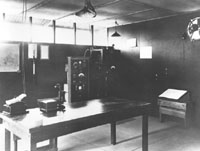


RAAF Meteorological Service
Foreword
Introduction
Chapter 1: The Weather Factor in Warfare
Chapter 2: Establishing and Developing the RAAF Directorate of Met. Services (D.Met.S)
Chapter 3: Recruiting and Training of Personnel
Chapter 4: Meteorology in Aviation
Chapter 5: The Met. Retreating
Chapter 6: The Met. Advancing
Chapter 7: The Met With the Army and the Navy
Chapter 8: Divisional Offices of the Bureau of Meteorology During the War
Chapter 9: Research and Instrumental Development
Research
Instrumental Development
Chapter 10: The End, Aftermath, and Beyond
Appendix 1
Appendix 2
Appendix 3
Appendix 4
References
Index
Search
Help
Contact us

Instrumental Development (continued)
In early 1943, Allan Cornish and Lieutenant-Commander Dimitrevic (USN) set up some 12 radiosonde stations, with the aid of Allied meteorological services, in New Guinea and northern Australia.[95]

The wartime radiosonde, which had been in use for several years in various forms in overseas countries, consisted of a balloon equipped with very equipment for automatically recording temperature, pressure and humidity at various altitudes. This information was simultaneously transmitted to radio signals receiving units on the ground. Observation by means of a network of radiosonde stations supplemented a large volume of other weather observations to provide a wealth of meteorological detail about the South-West Pacific area. Mellor reports that:
'The first pressure charts for levels of 10,000 feet and 20,000 feet were drawn regularly at the Tropical Research Centre (RAAF Command, Brisbane), and a daily statement of the pressure pattern at each level was issued to forecasting stations.'[96]

A useful side-product of radiosonde development was a battery for the airborne radiosonde unit. The plates in this battery had an infinite shelf life, and could be activated by the addition of sulphuric acid to each cell. At that time, layer—built dry cells could not be manufactured in Australia, and the shelf life of USA batteries had mostly expired by the time they were received overseas.
From an examination of RAAF files in the Australian Archives, Mitchell, ACT, it was noted that the increased load of instrument repair and maintenance necessitated in 1944, that a separate establishment be made at Sheppard House in Flinders Lane, Melbourne. This was to include provision for the calibration and maintenance of radiosondes. This section later became an important centre for testing and checking a wide range of Australian made aircraft instruments.
In charge of the instrument section from 1943 onward was Flight-Lieutenant George Elston, who was also an instructor with the Met. training section.
People in Bright Sparcs - Cornish, Allan William
 |
Bureau of Meteorology |  |
© Online Edition Australian Science and Technology Heritage Centre and Bureau of Meteorology 2001
Published by Australian Science and Technology Heritage Centre, using the Web Academic Resource Publisher
http://www.austehc.unimelb.edu.au/fam/0324.html